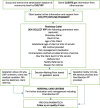Assessing feasibility and acceptability of increasing access to sexual and reproductive health and rights through pharmacy outlets and community health volunteers: lessons from pilot study in Kenya
- PMID: 39736716
- PMCID: PMC11684035
- DOI: 10.1186/s12913-024-12176-5
Assessing feasibility and acceptability of increasing access to sexual and reproductive health and rights through pharmacy outlets and community health volunteers: lessons from pilot study in Kenya
Abstract
Background: Both unintended pregnancy and unsafe abortion are major public health problems in Kenya. The World Health Organization recommends the use of medication abortion to stop unwanted pregnancies. However, the extent of provision and uptake of medication abortion through private pharmacies in Kenya is not well known. This study assessed the feasibility and acceptability of utilizing pharmacy outlets and community health volunteers to increase women's and girls' access to information, medication abortion and other sexual and reproductive health services and rights.
Methods: The study utilized a single arm (intervention only) pre-test and post-test design that involved implementing a set of interventions and comparing the baseline and endline indicators using simple frequencies considering the number of respondents involved in the study. The study, referred to as Tembe Mkononi project, was conducted from 1st February 2021 to 31st December 2022, in Homa Bay County. Data collection involved baseline and endline interviews with 10 pharmacy staff (drawn from 9 pharmacy outlets) and 20 community health volunteers while program data was extracted from pharmacy sales records.
Results: A total of 527 clients obtained medication abortion drugs from the 9 participating pharmacy outlets between April and December 2022. There was a steady increase in the number of clients served from 15 clients in April 2022 to 112 clients in December 2022. Out of the 527 clients, 523 of them obtained family planning methods. All the pharmacy staff and community health volunteers expressed satisfaction and positive attitude towards the services provided to clients.
Conclusion: Results of the study show that the provision of medication abortion and other sexual and reproductive health services such as contraceptives to women and girls through private pharmacy outlets was feasible and acceptable. Building the capacity of community health volunteers to create awareness, strengthen referral and follow-up activities increased demand and uptake of sexual and reproductive health services including medication abortion over the project period. Overall, the interventions implemented in a rural county in Western Kenya have potential in addressing the problem of unsafe abortion which is one of the leading causes of maternal morbidity and mortality in Kenya and other developing countries.
Keywords: Community health volunteer; Homa Bay County; Medication abortion; Pharmacy; Sexual and reproductive health and rights.
© 2024. The Author(s).
Conflict of interest statement
Declarations. Ethics approval and consent to participate: Research activities for this study were performed in accordance with the Declaration of Helsinki. Ethical approval for the Tembe Mkononi project was obtained from AMREF Ethics and Scientific Review Committee vide letter Ref: ESRC/P995/2021 dated 18th June 2021. A research license for the project was obtained in December 2021 from the National Commission for Science, Technology and Innovation (License number NACOSTI/P/22/15033). We confirm that written informed consent was sought and obtained from all the participating pharmacy staff and CHVs prior to conducting interviews. Before consenting, data collectors emphasized to participants that the study was voluntary, the reason they were participating and risks and benefits of participating. Consent for publication: Not applicable Competing interests: The authors declare no competing interests.
Figures












Similar articles
-
Medical abortion in Nepal: a qualitative study on women's experiences at safe abortion services and pharmacies.Reprod Health. 2019 Jul 15;16(1):105. doi: 10.1186/s12978-019-0755-0. Reprod Health. 2019. PMID: 31307474 Free PMC article.
-
Acceptability and feasibility of community-based provision of urine pregnancy tests to support linkages to reproductive health services in Western Kenya: a qualitative analysis.BMC Pregnancy Childbirth. 2022 Sep 1;22(1):674. doi: 10.1186/s12884-022-04869-8. BMC Pregnancy Childbirth. 2022. PMID: 36050632 Free PMC article.
-
Measuring the uptake of clinic-based HIV treatment and prevention services following HIV testing and referral at private pharmacies in Kenya.BMC Health Serv Res. 2025 Jan 4;25(1):23. doi: 10.1186/s12913-024-12165-8. BMC Health Serv Res. 2025. PMID: 39755595 Free PMC article.
-
Medical abortion offered in pharmacy versus clinic-based settings.Cochrane Database Syst Rev. 2021 Jun 11;6(6):CD013566. doi: 10.1002/14651858.CD013566.pub2. Cochrane Database Syst Rev. 2021. PMID: 34114643 Free PMC article.
-
Sexual and reproductive health services provided by community pharmacists: a scoping review.BMJ Open. 2021 Jul 26;11(7):e047034. doi: 10.1136/bmjopen-2020-047034. BMJ Open. 2021. PMID: 34312200 Free PMC article.
References
-
- World Health Organization (WHO) Factsheet. 2020. Preventing unsafe abortion. Geneva. https://www.who.int/news-room/fact-sheets/detail/preventing-unsafe-abortion
-
- Bankole A et al., From Unsafe to Safe Abortion in Sub-Saharan Africa: Slow but Steady Progress, New York: Guttmacher Institute, 2020, https://www.guttmacher.org/report/from-unsafe-to-safe-abortion-in-sub-Sa...
-
- Republic of Kenya. Constitution of Kenya 2010. Nairobi: Republic of Kenya; 2010.
-
- Center for Reproductive Rights. 2010. The impact of Kenya’s Restrictive Abortion Law. New York: Center for Reproductive Rights. Accessed at: publications@reprorights.org.
-
- Ministry of Health [Kenya]. 2003. Kenya National Post Abortion Care Curriculum: Trainer’s Manual. Nairobi: Ministry of Health.
MeSH terms
Grants and funding
LinkOut - more resources
Full Text Sources
Medical
Miscellaneous

